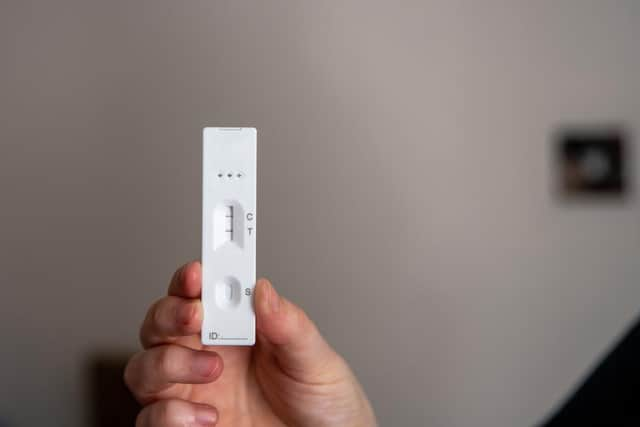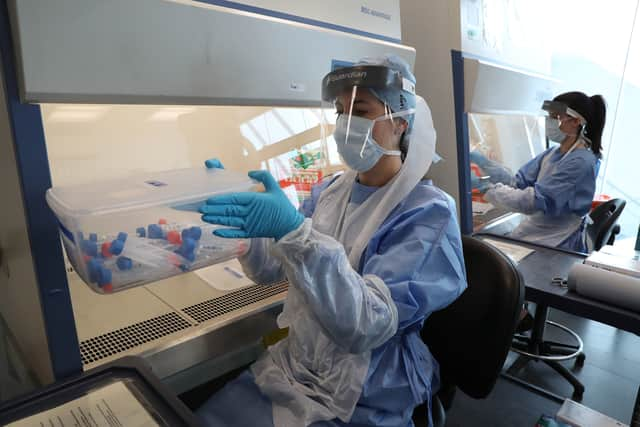How long do I have to self-isolate for if I have Covid? Latest self-isolation rules in Scotland
and live on Freeview channel 276
When you complete a Covid-19 test, there are three possible results you can get - positive, negative and void.
For a negative test you’ll get a strong red line at the C level and nothing at the T level. Two red lines - at the C and T marks - means you’ve tested positive. It doesn’t matter if the lines are strong or faded - it’s positive.
Advertisement
Hide AdAdvertisement
Hide AdIf you don’t get any red line whatsoever, or just a red line on the T, it means the result is void. Time to start again.
If you’ve tested positive, here’s our quick guide to helping you self-isolate.


Do I have to self-isolate if I test positive for Covid-19?
Prime Minister Boris Johnson announced last month that people living in England would no longer have to self-isolate if they tested positive for Covid-19.
While people south of the border have no legal obligation to self-isolate, it is recommended that they do so, to avoid passing it on to other people.
Advertisement
Hide AdAdvertisement
Hide AdHowever, in Scotland, self-isolation rules are still in place. If you’ve been told to self-isolate because you’re a close contact of someone who has tested positive, or because you’ve tested positive yourself, you must do so.
How long do I have to self-isolate for?
If you test positive, you should self-isolate for 10 days from the date your symptoms started.
If you’ve had a positive PCR or LFD test result but no symptoms, you should self-isolate for 10 days from the date of your test. You may go on to develop symptoms over the next few days, but you don’t need a confirmatory PCR test, unless advised by a clinician, and you don’t need to re-start your isolation period.
If you develop any of the main symptoms of coronavirus and you are concerned, or your symptoms are worsening, phone 111 or speak to your GP. In an emergency phone 999.
Advertisement
Hide AdAdvertisement
Hide AdYou may still have a cough or loss of, or change in, sense of smell or taste for several weeks. People with symptoms are very unlikely to infect others after the 10th day of illness.
Once you’ve completed your 10 day self-isolation, you can return to work and your usual activities (regardless of your LFD result) as long as you feel better and do not have a high temperature. You must continue to follow the Scottish Government’s coronavirus advice.
Can I end self-isolation early?
You are allowed to end self-isolation early, but only if you’ve had two negative lateral flow tests in a row from day 6 onwards, taken 24 hours apart.
You should also not have a high temperature and make sure you follow the guidance for staying safe when your self-isolation is complete.


Advertisement
Hide AdAdvertisement
Hide AdIf you continue to test positive on LFD tests, or choose not to take LFD tests to end self-isolation early, you can return to work and your usual activities on the 11th day after your symptoms started, as long as you feel better and do not have a high temperature.
If you’re still testing positive during a period of isolation and, rightly, reporting the positive test results, you may receive repeated isolation information from Test and Protect. You should not restart your isolation period, instead, you should continue to follow the advice you received following your first positive test.
What should I do after self-isolation ends?
Congrats, you’ve completed your self-isolation period and can return to the world. However, that’s not the end of the guidance.
Even if you end self-isolation, you should still limit close contact with people outside your home for the next 10 days, wear a face covering in enclosed spaces, limit contact with those at the highest risk for 10 days, keep taking lateral flow tests twice a week for the next 10 days, and not visit people in care homes and hospitals for that period as well.
Advertisement
Hide AdAdvertisement
Hide AdIf you’ve tested positive, count the 10 days from the date your symptoms started, or the date of your test if you do not have symptoms. If you’re a close contact, count the 10 days from the date of your last contact with the positive case.
What does self-isolation mean?
It means asking others to help you stay in the house, whether that means them picking up your food shopping or things you need.
Try and keep 2 metres apart from people at home, sleep alone if possible, wash your hands regularly, postpone any non-essential health appointments, and keep away from the elderly and those with underlying medical issues.
Find out more
For details on being a close contact, visit the NHS Inform website.
Comment Guidelines
National World encourages reader discussion on our stories. User feedback, insights and back-and-forth exchanges add a rich layer of context to reporting. Please review our Community Guidelines before commenting.
